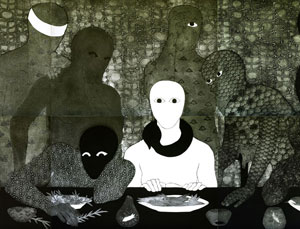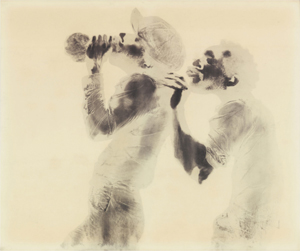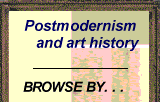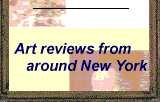The Self and Others
John Haberin New York City
Vital Signs: Artists and the Body
What It Becomes: Contemporary Self-Portraits
Lisa Yuskavage: Drawings
Surrealism called its experiments with collaborative art Exquisite Corpse, but what was so exquisite, and where is the corpse? Half a century later, Ted Joans wanted to know, and the questions haunt "Vital Signs: Artists and the Body" at MoMA.
Joans had every right to ask. The painter, poet, and filmmaker had been around himself, long enough to know André Breton, author of the 1924 Surrealist Manifesto. As an African American, he could count himself among the excluded, even by a movement meant to live on the edges of the acceptable. As a jazz musician as well,  he could only appreciate a form based on improvisation and collaboration. In the original corpses, each contributor could see only the latest addition (and only in part at that) before adding more. Joans conducted his version more blindly still, by mail.
he could only appreciate a form based on improvisation and collaboration. In the original corpses, each contributor could see only the latest addition (and only in part at that) before adding more. Joans conducted his version more blindly still, by mail.
Its thirty years of submissions, starting in 1971, add up to a long accordion book indeed, in a display case that makes you, too, take it one drawing at a time. Mailing labels and envelopes that got it here lie in disorder on the floor. Here, too, nothing is all that exquisite, the corpse as elusive as the artists were far away. So where is the body? It is the theme of "Vital Signs," recent work from MoMA's collection. If it remains elusive, such as art today.
Every self-portrait is a boast as well about the mark of the artist—a double boast. Yes, I am a worthy subject, and yes I can pull it off with my art. With "What It Becomes" years later at the Whitney make that a triple boast. Yes, its adds, I am worth hiding, too. There was more to me than you saw all along, and it is up to you, the viewer, to find it. As David Hammons has it, Close Your Eyes and See.
Speaking of suggestive bodies, What is Lisa Yuskavage doing at the Morgan Library? As ever, begging for attention, and who could refuse? Since at least 1990, she has been putting young women and children in embarrassing poses and refusing to be embarrassed. Is it feminism, if only what critics have called "bad feminism"? She might call that a compliment, from an artist whose titles include Bad Babies and Bad Habits. And the provocations continue, with what you might be tempted to call "bad drawings," but she could call that a compliment, too.
Where is the body?
If Ted Joans was awfully late for the extended party, so is the Modern. The curators, Lanka Tattersall with Margarita Lizcano, call the show "an expanded account of abstraction," but abstraction had been losing authority even before it begins. Painting made its return all right, but where anything goes, including an ill-defined mix of abstraction and story-telling. One takes for granted now women artists riffing on the female body in art. The History of Her Life Written Across Her Face, by Margo Humphrey, could stand for them all. If her black face looks much like a mask and the images have spread to miniature suns and a crucifix on each shoulder, all the better.
That opening room, for "Mirrors," and the closing room with Joans and "Multitudes" sum things up. Artists are there now, at the center of their fantasies and fears, but then so is everyone else. Nothing new here either, and one can predict easily enough what comes up. That includes the usual suspects, like Frida Kahlo (that face), Eva Hesse (a breast with a penis), and Louise Bourgeois (so many bodily spaces, not all of them yours or her own).  Mary Kelley weaves a personal postpartum record, much like pregnancy and motherhood for Julia Phillips at the 2024 Whitney Biennial. The show ends with a younger voice, Barbara Hammer, intoning deep thoughts on the primacy of touch before the naughty bits get going.
Mary Kelley weaves a personal postpartum record, much like pregnancy and motherhood for Julia Phillips at the 2024 Whitney Biennial. The show ends with a younger voice, Barbara Hammer, intoning deep thoughts on the primacy of touch before the naughty bits get going.
Never mind a certain lack of novelty. This is, after all, a museum collection, receiving a welcome emphasis since MoMA's 2019 expansion. "Vital Signs" may not look all that vital, but more than a hundred works by sixty-five artists will do—and the collection continues upstairs and down, with its room for Jackson Pollock and true abstract art labeled "Fields and Figures." True, the themes feel forced and almost impossible to tell apart. When Adrian Piper has the exquisite taste to take Immanuel Kant and yoga with him on vacation, why does his painted mirror go dark? When Maren Hassinger sets out thirty-two black bundles of wire and rope, are they not multitudes, too?
The thematic layout also offers little help with chronology or artists. Just how, since the 1970s, did art get this way—or was it there all long? MoMA leans to the latter, but I am not so sure. Jackie Winsor blackens Minimalism along with her charred cube of wood pallets, but it seems a long way from the prints right behind it. Lorna Simpson shows only her back, her shoes, and the labels that a black woman hesitates to wear. Lynda Benglis turns up three times, but not posing with a prick.
Still, the show has plenty of shared strategies and impressive work. Colorful drapery by Rosemary Mayer has its dark echo in Mrinalini Mukherjee and a suit of black hemp. When Charles Gaines reduces a woman's face to pixels and Maria Lassnig distorts her own on color TV, they are analyzing and reconstructing gender. So is Ana Mendieta, who changes her image simply by making up. Greer Lankton speaks of her art as an act of self-construction, though her "contortionist" makes more sense alongside Blondell Cummings, who turns a black woman's household labor into "interpretive dance." Nor is Rebecca Horn the only artist to see her life on video as a dream, a journey, or a trance.
The dualism of mirror and multitudes could even amount to a theme. While art as the mirror of nature has lost favor, it still casts its multiple reflections. Senga Nengudi has her supremely tactile nylons weighed down not by her legs, but by sand, and its rise and fall here extends many times over. Belkis Ayón offers herself as a gathering and A Challenge in black and white. And Kiki Smith inserts cut-out flowers into portraits as herself and as a worm. One could almost call it exquisite or a corpse.
Vanishing act
Self-portraiture's dual or triple nature goes back to its origins, in the Renaissance. An artist like Albrecht Dürer could boast not just of his skill, but of a new-found status relative to his patron as well. For Dürer in silverpoint at age thirteen, he had not yet even earned a patron. With "Hidden Faces," covered portraits of the Renaissance at the Met last spring, every portrait was also a mask. Its sitter, after all, had an image to convey, too. By the end of 1960s, though, when the Whitney begins, the mask itself became a place to hide.
"What It Becomes" does not speak of masking. It calls art a way "to reveal the unseen" and to "make the familiar unrecognizable." In other words, it is about self-creation. The curator, Scout Hutchinson, also speaks of art's material presence, even in a space largely dedicated to works on paper from the museum's collection, just outside the education department. It is about "inscription, erasure, and tactility." It is a vanishing act all the same.
Presence is as presence does, starting with David Hammons. His body prints put himself into the act, but not to show his face. Famously reclusive, he reveals nothing, least of all his skill in drawing. They might as well be tire treads. He confronts, too, a black's invisibility to white eyes or, worse, violent removal. Body prints by Yves Klein in blue, not in the show, seem an empty boast by comparison. 
The small show could be a catalog of strategies for vanishing. Some play the part of others, like Darrel Ellis in black wash, posing after a photograph by Robert Mapplethorpe. Wendy Red Star leaves herself out entirely in favor of a leading Native American around 1880. The same red outlines in ink-jet prints frame her text and a hatchet in his hands, both as weapons. Toyin Ojih Odutola gives black skin to "famous whites." Jim Hodges works with his own saliva, but the results look more like pond scum than a portrait.
Naotaka Hiro promises to Map His Body, with pretty enough colors but not much else. Others appear explicitly, but masked. Rick Bartow takes on the teeth and smile of a wild animal, in pastel and pencil. And Hassinger takes pains to apply her mask, like a woman applying makeup, but as blackface. I cannot say for sure whether her video celebrates, defies, or condescends to gender and race, but it resonates. Blythe Bohnen acquires her mask simply by time-exposure, so that the blur of her features serves as a beard.
Catherine Opie hides behind nothing more than her back and its blood-red incisions. And Mendieta herself, never one to hide, brings one last strategy for vanishing. She sets an effigy on fire, leaving her very body image in flames. Self-portraits have become all but a ritual these days, as an affirmation of personal and cultural identity. These eleven artists look back to a time after Modernism when such things came with irony and pain. For all their flaws, they could still mean more than what it all became.
Bad drawings
Not that Lisa Yuskavage draws all that badly. She received her MFA from Yale, in a class with John Currin, and did her homework. The curator, Claire Gilman, stresses her investment in traditional media, although none are out of the ordinary for a working artist. Wall text speaks of her building on Tintoretto and Pontormo in the sixteenth century, although I could not spot the quotes. But then I have myself written of Mannerism in Italy as the Post-Renaissance, much as Yuskavage helped create a Postmodernism. Hired to teach watercolor, she made sure to read an old tract on the subject as well, the older the better.
The hype began even before the 2000 Whitney Biennial, in a new wave of realism and irony along with Currin. If you did not expect to see those two words together, you were behind the times. Now she has the Morgan's small lobby gallery for just forty works on paper, but it could easily claim a retrospective. It goes lightly on the unaccompanied standing women that first gained attention, but it opens with a female bust squat on the ground at sunset, like a living sphinx. It is not far from there to what another drawing calls Tit Heaven. But whatever is she doing at the Morgan?
I took the question literally just before, but the provocation points to something larger. The museum is, increasingly, acquiring and exhibiting recent art—and treating it as normal. It did, after all, subtitle its last show in that very room "Imagining the Medieval World." Its larger galleries feature Julia Margaret Cameron, the early photographer, as "Arresting Beauty," and it could easily be speaking of Yuskavage. The painter, in turn, can hardly mind finding a place in history. She just happens to render sunset in neon colors, with air balloons as perfectly rounded tits.
Like many women in art, she is taking command of the female body in myths of her own making—give or take quotes from dead Italians. So which is she, ironic or arresting in her beauty? The whole point not to answer. Her style has more to do with soft-core porn or greeting creating cards than academicism or feminism, but that is what makes it ironic or arresting. She does and does not conform to whatever ideal you like. More and more these days, that includes her ideals in her best-known work.
Tired of balloon breasts and coy poses? Dysfunctional Dancer has small, ridiculously pointy breasts and arms behind her back—or missing entirely. Sunset opens onto desolate but alluring landscapes, its women lit from behind. Trees might be withering, and a silhouette seems right out of Georges Seurat and bourgeois France. In each case, Yuskavage is pushing back and taking in. And that means art as theater, with suitably bad actors to bring it alive.
Acting for her is both pretense and everyday life. Recent work picks up on another old genre, the artist in the studio. Never mind that Yuskavage never shows up, and the scenes have no obvious moral—about the nature of art or anything else. The artist's model comes in her place, and a model is always modeling. Yuskavage buys the outfits, and her friends put on a show. It still drives me crazy, and I still cannot join in the celebration of cliché, but I still look.

"Vital Signs" ran at The Museum of Modern Art through February 22, 2025, "What It Becomes" at The Whitney Museum of American Art through January 12. Lisa Yuskavage ran at The Morgan Library through January 4, 2026.




